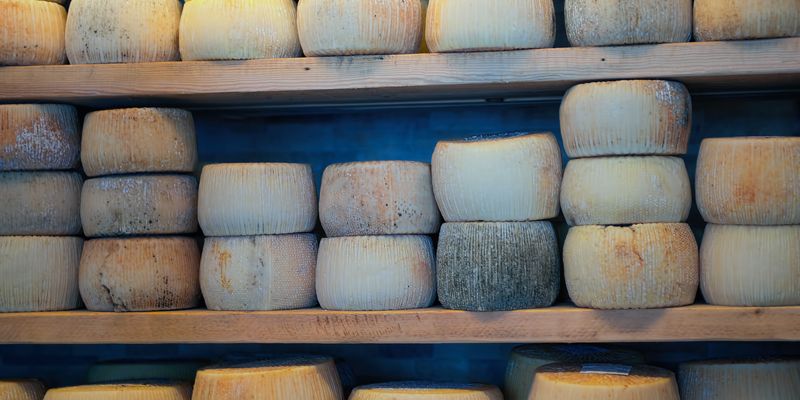Picking up a beer-brined cheese, examining, sniffing and then, finally, consuming it, is analogous to getting into a relationship with a firefighter or a stripper.
Reality trumps visual and olfactory signifiers.
Peer at any hunk of dairy aged in beer or cider, and one will generally find a round hunk of rather intimidatingly “serious”-looking cheese with a pronounced, wrinkled rind. Easy now.
Take a sniff. Distinct notes of sweaty sock excavated from an ancient barnyard’s dung pile waft forth. Feeling brave, picturing a victorious post on Instagram as compensation for the potential funk overload?
Go ahead, spread it on a cracker, see what happens. What’s this?
There’s an overwhelming taste sensation of savory creaminess, coupled with spicy, hoppy overtones and a chorus of sweet grass and sun-toasted earth bringing it all home. It’s harmonious, balanced, complex: the bite-size flavor combo we’re all aiming for when pairing a bite of protein with a bracing lash of bitter and nip of sweet, all in one neat package.
Beer-brined cheeses represent one of the few categories of food in which smell and taste don’t align – unless you gnaw exclusively on the funky rind. For most Americans who don’t subscribe to Cutting the Curd or spend a lot of time hanging around their local cheese counter, beer-brined cheese, as opposed to beer cheese, is still a tragically misunderstood anomaly.
We just don’t have the same base-level culture of cheese here that exists in Europe, though our most talented artisans, scientists and farmers have collaborated and worked tirelessly together in the last 10 years to make American cheese great again. Move over Velveeta, aged butterkäse and Reblochon are coming to town.
While most of us spent our youths consuming plastic packets of American cheese – a product made from unfermented dairy by-products, emulsifiers, vegetable oils, salt, food coloring and sugar that resembles cheese the way Juicy Fruit resembles fruit – we would no sooner tell our current or future offspring to play in traffic than present them with the dreaded Kraft Single as a form of sustenance.
Most of us now know our Alpines from our bloomy rinds – and we understand that, as with wine, certain regions of the world (Munster, Vacherin, Parmigiano-Reggiano, etc.) produce cheeses of the same name.
Murray’s Cheese has been at the vanguard of the American cheese-improvement movement since a Jewish veteran of the Spanish Civil War named Murray Greenberg first opened his doors as a humble cheese and eggs corner store in 1940. In 2004, Murray’s introduced the ancient art and science of ripening cheese in caves to America when it built a cheese cave under its shop on Bleecker Street (one of, if not the, first cheese caves in the country).
In 2013, Murray’s expanded its cave facilities operation to Long Island City. In many ways, it’s the Anchor Brewing Co. of the cheese world. It has managed to sell its wares on the mass market (it has a serious presence around the country through its specialty cheese bars in more than 300 Kroger’s grocery stores) without selling its soul.
Murray’s helped revolutionize the art, craft and understanding of cheese in America, feeding and educating hundreds of thousands of curious consumers along the way. But most importantly, it has built, and some even dare say, improved on the ancient art of washing cheese in a bracing bath of beer, most notably through its Greensward (a big winner at the American Cheese Society’s annual competition).
VinePair tapped Steve Millard, Vice President of Food Service and Merchandising at Murray’s Cheese, for a the DL on what in tarnation beer-washed cheese is, which ones we should try and more importantly, what in God’s name we should drink with the stuff.
But first, some background. European monasteries have produced their own food and beverages for centuries to sustain themselves, and cheese became a go-to for them as a relatively inexpensive and highly nutritious source of protein when meat was out of reach for religious reasons. Monks have also famously made beer for centuries as well, because beer.
In the 1800s, Trappist monks broke off from the mainline Cistercian branch to follow the teachings of the 6th-century monk St. Benedict more closely. At the center of his teachings was the notion that monks should produce, by the works of their hands, food for themselves and the poor. He also forbade the flesh of four-footed animals except for the sick and weak. All monks were expected to work in the kitchen.
Alcohol was allowed.
Trappists, most notably the monks at the Abbaye of Notre-Dame de Scourmont in Chimay, Belgium, went on to produce some of the world’s most beloved carbohydrate and protein conveyance systems in the form of Chimay – not just a beer, a cheese, too. They opened a dairy and brewery in 1862 and started brining their unripened “green” cow cheeses, sometimes with spring water, sometimes with their famous Chimay.
So how does the fancy monk magic happen, and how do plain old Americans pull it off? Can I throw Velveeta and PBR in a blender, bzzzz, and then, like, set it on my counter until Friday for some DIY flavor fun?
“Well, the science hasn’t changed much over the centuries,” Steve says. “It’s the same deal: surface-ripened cheese are treated with a brine, which controls the type of bacteria that grows on the cheese. Caves provide the best environment for cheeses to mature because we can calibrate them so the temperature, humidity and microbial activity can be precisely monitored and controlled.”
Cheesemakers don’t want just any bacteria to thrive either. Each section of the cave – there’s a bloomy rind, a washed rind, a natural rind and an Alpine section – has different levels of humidity and temperature. In the washed-rind section, dubbed the stink tank, cheese gets various water or booze spa treatments made in the caves themselves, Steve explains. “The contents of the brine influence the flavor of the cheese as it ripens. Microbes eat the sugars in the beer or cider brine, creating the rind and the soft interior. But it takes time, the correct environment and no, not just any beer and cheese base will work successfully. The baseline products have to be good, and then it’s what you do with them that counts.”
And while, as Steve points out, the science of how a bucket of milk turns into a hunk of scrumdiddlyumptious casein coagulation may not have changed, the particulars of the process differ from maker to maker, even within the evolutionary arc of one product itself.
“Our process has changed significantly,” Steve explains. “Our first version of Greensward was created exclusively for Eleven Madison Park restaurant’s New York-inspired menu four years ago. The recipe was developed by the team at Jasper Hill Farm and the aging process was a collaboration between us at Murray’s, Jasper Hill and chef Daniel Humm. We washed the cheese in beer from Ithaca Brewing made exclusively for Eleven Madison Park and then aged it in our caves. Three years ago, we moved to a much bigger facility and then a year after that, Jasper Hills started sending us completely green cheese without even the beginning of a rind so we could basically build the cheeses from the ground up. That was a game changer. It revolutionized our approach; we started washing it less, changing the wash from beer to a Virtue Cider with some added yeast, then we started aging it less and the result is a more nuanced cheese.”
Pairing this delectable cheese with a beverage is tricky. “The common rule of thumb with anything food and beverage related is, what grows together, goes together,” Steve says. “We say it again and again for a reason. If you can pick up the beer or cider that the cheese was washed in, or at the very least, one from the same region and made in the same style, it will enhance the cheese without overpowering it. Greensward doesn’t taste like Virtue Cider, but it picks up some of its notes, and it makes for a harmonious pairing.”
Greensward may be serious, but like all beer-washed cheese, it loves a good party. “We serve it at our Cheese Bar as a fondue in the summer because it has that runny texture automatically without needing to be heated,” Steve explains. “Dip a little chorizo, house-made pickles or crusty breads in and it’s even more amazing.”
Here are four of the best beer bathed cheeses for your next DIY fondue:
Greensward
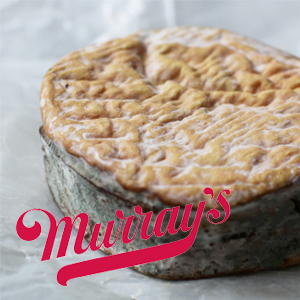 Produced by New York’s Murray’s Cheese. Inspired by Forsterkase, Winnimere and the Vacherin Mon d’Or cheeses, it is named for the oasis of greenery that became Central Park and was originally referred to as the Greensward Plan. It’s a spectacular pasteurized cow’s milk cheese with a silken texture and notes of pine and resin.
Produced by New York’s Murray’s Cheese. Inspired by Forsterkase, Winnimere and the Vacherin Mon d’Or cheeses, it is named for the oasis of greenery that became Central Park and was originally referred to as the Greensward Plan. It’s a spectacular pasteurized cow’s milk cheese with a silken texture and notes of pine and resin.
The Grand Classique Chimay
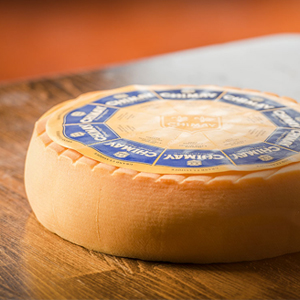 Produced by Abbey of Notre-Dame de Scourmont in Belgium. It’s a semi-soft pasteurized cow cheese sourced from herds within 18 miles of the dairy. The Grand Classique is mild and creamy, aged for three weeks in Chimay Première’s slightly fruity wash.
Produced by Abbey of Notre-Dame de Scourmont in Belgium. It’s a semi-soft pasteurized cow cheese sourced from herds within 18 miles of the dairy. The Grand Classique is mild and creamy, aged for three weeks in Chimay Première’s slightly fruity wash.
Good Thunder
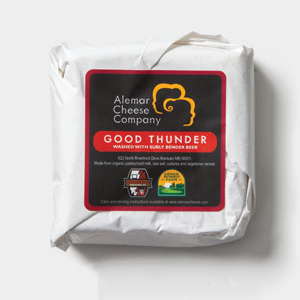 Produced by Mankato, Minnesota’s Alemar Cheese, this is a washed-rind square loosely inspired by Reblochon and washed in Surly Bender Beer, cultures and salt for three weeks.
Produced by Mankato, Minnesota’s Alemar Cheese, this is a washed-rind square loosely inspired by Reblochon and washed in Surly Bender Beer, cultures and salt for three weeks.
Trifecta
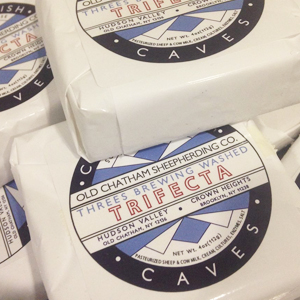 Produced by New York’s Crown Finish, this mixed milk triple crème made by Old Chatham Sheepherding in the Hudson Valley. It’s washed in Wandering Bine Saison from Brooklyn’s Three’s Brewing and aged for three weeks in the Crown Finish caves in Brooklyn. The cheese caves are located in the old lagering tunnels of the Nassau Brewery and were opened in 2014.
Produced by New York’s Crown Finish, this mixed milk triple crème made by Old Chatham Sheepherding in the Hudson Valley. It’s washed in Wandering Bine Saison from Brooklyn’s Three’s Brewing and aged for three weeks in the Crown Finish caves in Brooklyn. The cheese caves are located in the old lagering tunnels of the Nassau Brewery and were opened in 2014.

